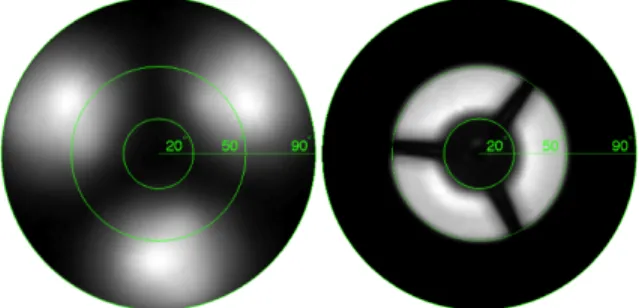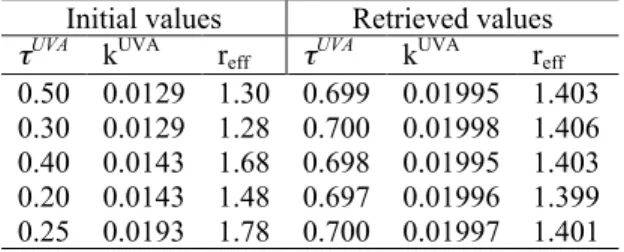HAL Id: insu-01624225
https://hal-insu.archives-ouvertes.fr/insu-01624225
Submitted on 26 Oct 2017
HAL is a multi-disciplinary open access
archive for the deposit and dissemination of
sci-entific research documents, whether they are
pub-lished or not. The documents may come from
teaching and research institutions in France or
abroad, or from public or private research centers.
L’archive ouverte pluridisciplinaire HAL, est
destinée au dépôt et à la diffusion de documents
scientifiques de niveau recherche, publiés ou non,
émanant des établissements d’enseignement et de
recherche français ou étrangers, des laboratoires
publics ou privés.
Retrieval of martian dust and cloud properties from
ground-based radiance sensors observations
Daniel Toledo, Pascal Rannou, Ignacio Arruego, Jean-Pierre Pommereau
To cite this version:
Daniel Toledo, Pascal Rannou, Ignacio Arruego, Jean-Pierre Pommereau. Retrieval of martian dust
and cloud properties from ground-based radiance sensors observations. European Planetary Science
Congress 2017 (EPSC 2017), Sep 2017, Riga, Latvia. pp.EPSC2017-419-2. �insu-01624225�
Retrieval of martian dust and cloud properties from
ground-based radiance sensors observations
D. Toledo (1), P. Rannou(2), I. Arruego (3) and J.-P. Pommereau (4)
(1) Department of Physics, University of Oxford, Parks Rd, Oxford OX1 3PU, UK, (2) GSMA, UMR 7331, CNRS, Université de Reims Champagne–Ardenne, Reims, 51687, France, (3) Instituto Nacional de Técnica Aeroespacial (INTA), Spain, (4) LATMOS, Université de Versailles-St-Quentin, Guyancourt, France, (daniel.toledocarrasco@physics.ox.ac.uk)
Abstract
On Mars, dust and clouds are primary elements for studying the interactions of solar radiation with the atmosphere and surface and their influence on the radiation balance. Depending on dust opacity and parameters such as size distribution, airborne dust can provide positive or negative radiative feedbacks into dynamical processes. This role played by dust in the circulation of the martian atmosphere points out the need of retrieving the concentration and physical properties of dust at different time periods and locations.
In order to address those measurements a number of ground-based sensors were selected for Exomars missions: the solar irradiance sensor (SIS) [1,2] selected for Exomars 2016 and 2020, and the optical depth sensor (ODS) [3,4] selected for Exomars 2020. These instruments measure the solar flux at two wavelengths (UVA and NIR) and have a specific field of view (FOV) (see Figure 1) that allows them to measure the scatter flux and the direct flux at different time intervals during the course of the day. In this work, we will discuss different retrieval procedures developed for ground-based sensors. We first perform several sensitivity tests of the sensors signals to parameters such as the dust opacity and size distribution to establish which dust parameters can be retrieved by the different sensors. Subsequently, in order to adopt for each sensor the retrieval procedures capable to obtain as much information as possible on the optical properties of martian aerosol, we will evaluate different configurations of the procedures as well. A similar study will be presented for the detection and characterization of martian clouds.
1. Description of the model
The retrieval procedure for dust is based on the use of radiative transfer simulations reproducing the signals that should be observed by the instruments as a function of key dust parameters: size distribution (reff, νeff), refractive index (m=n+ik) and opacity (τ).
These different parameters can be whether retrieved or fixed in the model. The selection of the free parameters during the retrieval depends on the instrument properties (e.g. FOV or sampling frequency) and it is based on several sensitivity analyses. The phase function and single scattering albedo are computed using T-Matrix method [5] through the refractive index and the size distribution.
Figure 1: Measured FOV of SIS’16 (left) and ODS (right). White and black areas correspond to 100 and 0 % of transmission, respectively. The SIS FOV is employed using a total of three sensors oriented at different zenith angles while the ODS one using only one sensor and optical components.
For the cloud detection, the index colour (CI) is used, defined as the ratio between the scattered light at NIR and UVA wavelength ranges. If a cloud is present during twilight, then a minimum must be observed in the time variation of CI [2,3,4]. The retrieval procedure is similar to the one for the dust but with EPSC Abstracts
Vol. 11, EPSC2017-419-2, 2017
European Planetary Science Congress 2017 c
the addition of two more free parameters: the cloud opacity and altitude. In order to test the reliability of the retrieval procedure, we simulated the signals of the sensors for specific values of τ, m, reff and νeff,
and then we added a random noise of amplitude 5% (OMars). Subsequently, those signals were analyzed by
the retrieval procedure using different initial conditions. Some examples for the three UVA sensors of SIS’16 instrument are illustrated in Figure
2 and Table 1.
Figure 2: Comparison between OMars signals computed for τUVA=0.7, mUVA=1.5+i0.02 and r
eff=1.4
µm (grey solid lines), and those simulated using the retrieved (black solid line) and a priori (black dashed line) values of the free parameters illustrated in first line of Table 1.
Table 1: Retrieved values of τUVA, kUVA and reff when
applying the procedure to OMars signals computed for
τUVA =0.7, mUVA =1.5+i0.02 and reff=1.4 µm, and
using different a priori values in the retrieval procedure.
Initial values Retrieved values τUVA kUVA r
eff τUVA kUVA reff
0.50 0.0129 1.30 0.699 0.01995 1.403 0.30 0.0129 1.28 0.700 0.01998 1.406 0.40 0.0143 1.68 0.698 0.01995 1.403 0.20 0.0143 1.48 0.697 0.01996 1.399 0.25 0.0193 1.78 0.700 0.01997 1.401
2. Terrestrial validation
In addition to the sensitive analysis performed to the sensors, the ODS and SIS’16 participated in different terrestrial campaigns in Africa in 2004 and 2014,
respectively [4, 1]. We will discuss the results of these campaigns for which the two sensors were compared against photometer observations. For example, Figure 3 shows a comparison between ODSand a AERONET photometer that was localized at the same place during the campaign in Africa in 2004.
Figure 3: Correlation between ODS UVA channel and AERONET aerosol opacity at 370 nm.
References
[1] Arruego, I.: DREAMS-SIS: the Solar Irradiance Sensor on-board the ExoMars 2016 Lander. Advances in Space Research. https://doi.org/10.1016/j.asr.2017.04.002. [2] Toledo, D., et al.: Measurement of dust optical depth using the solar irradiance sensor (SIS) onboard the ExoMars 2016 EDM. Planetary and Space Science 138 33– 43 (2017).
[3] Toledo, D., et al.: The optical depth sensor (ODS) for column dust opacity measurements and cloud detection on martian atmosphere. Exp. Astron. http://dx.doi.org/10.1007/s10686-016-9500-7.
[4] Toledo, D., et al.: Measurement of aerosol optical depth and sub-visual cloud detection using the optical depth sensor (ODS). Atmos. Meas. Tech. http://dx.doi.org/10.5194/amt-9-455-2016.
[5] Mishchenko, M.I.: Light scattering by randomly oriented axially symmetric particles. J. Opt. Soc. Am. A 8 (6), 871 (1991).

